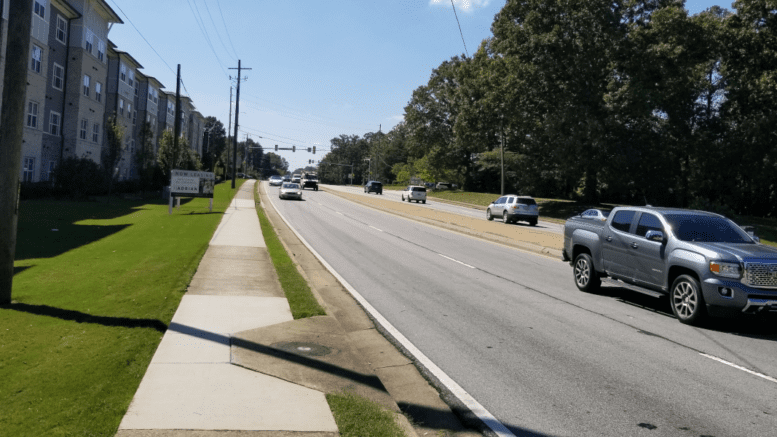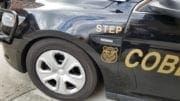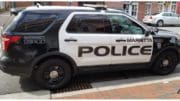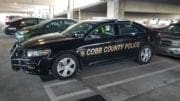[Photo: A busy portion of Austell Road where a pedestrian death occurred recently: Larry Johnson/Cobb County Courier]
Traffic accidents, particularly those involving death or serious injury, get a lot of readership, so I’m sure some of you have noticed that the Cobb County Courier’s traffic accident coverage seems different from the coverage we’ve done in the past.
Here are the reasons for that.
As editor and publisher of the Courier I’ve been dissatisfied with the way we’ve been covering accidents for a long time. Our coverage has tended to be like the coverage of most media organizations, where the articles were mostly rewrites of the information provided by the police PIOs (public information officers).
From the perspective of traditional journalism there’s nothing wrong with that. PIOs have no reason to present inaccurate information, or to “spin” stories, unlike media relations officials in more purely political organizations and agencies. Investigators (usually STEP Unit officers) write a report, the PIO gets it into shape for distribution, and it goes out to the media.
However, those public information releases come to us written in what journalists call “copspeak,” and copspeak carries with it some assumptions.
I’m just going to focus on one example of copspeak, because to me it’s one that gets to the heart of why journalists need to change their approach to coverage. It will also makes clear why I’ve made a decision that we’re not going to continue writing articles the way we’ve done in the past.
Here’s a quote from a police public information release: “Preliminary information indicates that an unidentified pedestrian was crossing Austell Road outside of a marked crosswalk in an unlit portion of the roadway.” Here’s the Courier’s article about it in case you want to read it.
Note the phrase “outside of a marked crosswalk.”
That carries with it an assumption that the pedestrian should have gone to a crosswalk to cross the road.
I was working at my desk in Austell Cowork when I got the public information release about that accident, near Austell Road (but as it turns out not very near to the accident site). So I decided to drive there and check out the conditions at that location.
Before leaving I also had a conversation about it with Matt Stigall, who knows a lot about issues involving Cobb County transportation and pedestrian safety issues, and he made some good suggestions.
A few things became obvious on visiting the site. One was that conditions for pedestrians on that part of Austell Road are never safe. Drivers travel too fast, and the only accommodation for pedestrians who want to cross the road is a bare concrete median strip separating the two sides of the road.
Most importantly, the nearest crosswalk to the location is a quarter mile away. That means if the pedestrian is going directly to the other side of the road, they have to walk a half mile to reach a destination less than 200 feet away.
No one is going to do that, and it make the observation that the pedestrian was not in the crosswalks pointless.
Also consider the second part of the quote from the public information release, “in an unlit portion of the roadway.”
Why is that portion of roadway unlit? And also, was the driver moving too fast to respond to things in the auto’s headlights?
So I’ve made a commitment to do the following things when possible:
- Visit the site and compare what’s found to the conditions at the site of the accident.
- Find out whether there are a lot of accidents at that site. One way of doing that is by visiting the Cobb Comprehensive Safety Action Plan, which has an excellent heat map of the worst parts of the county’s road system for accidents. If you haven’t read that report yet, you should. It’s an excellent overview of road conditions in the county.
- Phone the police PIO and get any additional information that’s available. Don’t just do stenography, phone or email.
- Eliminate “copspeak” from what we write. Humanize the language. Someone was injured or killed.
- Always be refining the way we report on accidents, and figure out ways of getting more complete information.
- There really are very few unavoidable accidents, and the Courier should report in such a way that highlights solutions, whether it’s engineering for safety, or education to help people become better drivers.
- Be fair to everyone involved. The point isn’t to assign blame, whether it’s to drivers, pedestrians, police or journalists. It’s to present information in such a way that solutions become evident.
One final thing I should mention is that I’ve had an increasing number of reports of death and injury to practice on. I haven’t done a general survey to find out if deaths and injuries are occurring across the board, or if this is just a coincidental statistical blip. But my inbox seems to indicate that serious accidents are more frequent.




